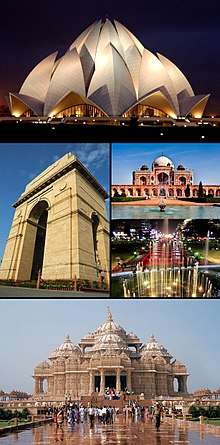
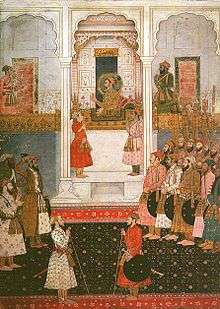
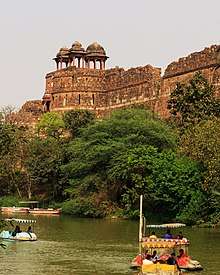
New Delhi is the capital of India and seat of the executive, legislative, and judiciary branches of the Government of India. It is also the centre of the Government of the National Capital Territory of Delhi. New Delhi is situated within the metropolis of Delhi and is one of the eleven districts of Delhi National Capital Territory. New Delhi constitutes roughly 1% of the population of Delhi metropolis. With a population of 22 million in 2011, Delhi metropolitan region is the world's second most populous city and the largest city in India and also one of the largest in the world in terms of area.
The foundation stone of the city was laid by George V, Emperor of India during the Delhi Durbar of 1911. It was designed by British architects, Sir Edwin Lutyens and Sir Herbert Baker. The new capital was inaugurated on 13 February 1931, by India's Viceroy Lord Irwin.
Quotes
- With evidence of continuous settlement dating back to the 6th Century BC, Delhi is one of the oldest inhabited cities in the world. The legendary city of Indraprastha from the epic Mahabharata is said to have been situated where Delhi now lies. Thought to have been built and destroyed 11 times, evidence of at least eight distinct settlements can still be seen in Delhi.
- Rakesh Kumar Bhatt, in History and Development of Libraries in India, Mittal Publications, 1 January 1995, p. 172
- Indraprastha was the town founded by the Pandava brothers of Mahabharata fame as their capital. Here, the eldest among them, Yudhishthira, became the “ruler of righteousness” (dharma-râja). ... The new town was dedicated to Indra. ... Indraprastha was founded as the capital of the Pandavas’ small-time kingdom but the area was destined by fate to become the capital of the Delhi Sultanate, the Moghul Empire, Samrat Hemachandra’s short-lived Empire, British India spanning the whole Subcontinent, and now the Indian Republic. It is a source of pride, and worth celebrating, that here, the “righteous ruler” once chose to highlight the great universal ideas personified in Indra. Therefore, the open-minded Delhiites all agree: Indraprastha amar rahe!
- About Indraprastha, the oldest part of Delhi. Elst, Koenraad. Hindu Dharma and the Culture Wars. (2019). New Delhi : Rupa.
- Delhi, also known as Dilli or Dehli, and in earlier incarnation as Indraprastha and Yoginipura, has an ancient past.
- A.G. Krishna Menon, in Delhi: A Heritage City: 20 Walks through History, INTACH, Delhi Chapter, 19 November 2013, P.9
- Much of Delhi’s regional importance came from the location in the watershed between the Ganga and the Indus river systems...In the sixth century BC, Delhi formed part of the Kuru kingdom, one of the Mahajanapadas or ‘great states.’ In the Buddhist documents of that period, Indapatta (identified with Indraprastha) is mentioned as the capital of the Kuru state.
- A.G. Krishna Menon, in "Delhi: A Heritage City: 20 Walks through History", P.9
- One evidence of the continuing importance of Delhi, as a location in the third century BC, is the inscription (edict) engraved here on the instruction of the Mauryan emperor Ashoka... the edict is to be found on a rock in the area in modern Kalkaji.
- A.G. Krishna Menon, in "Delhi: A Heritage City: 20 Walks through History", P.9
- Although constructed of destroyed Hindu temples, the Mosques at Old Delhi and Ajmer once and for all set the fashion to be followed by later mosques in Muslim India…
- Syed Mahmudul Hasan, Mosque Architecture of Pre-Mughal Bengal, Dacca (Bangladesh), 1979.
- I asked my soul: What is Delhi?
She replied:The world is the body and Delhi is life.- Mirza Asadullah Khan Ghalib, in Khushwant Singh Delhi: A Novel, Penguin UK, 1 September 2010, p. 16
- A Paradise, that's Delhi
Humpty Dumpty, hocus pocus, hurly burly
If there is a paradise on earth, it is Delhi
Full of people, overflowing
Markets onto the road going
Full of fumes, full of gases
Full of ultra modern asses
Full of shining, made-up faces
Full of heart and cancer cases
Car and truck and motorcycle
Full of vehicle on the vehicle
Full of jolting, full of stoking
Full of lanes and bylanes choking
Full of housing haywire going
Full of sewage into Jamuna flowing
Full of callous indifference breeding
Full of pastures fast receding
Full of power, and still power crisis
Full of smoothly rising prices
Full of girth and grime and mirth
Our Delhi is a paradise on earth.- Khushwant Singh, in Who will be our next President?, Hindustan Times, 13 April 2007

- We had admired the presidential palace and parliament houses, paused beside the striking India Gate, inspected the 16th Century Humayun's Tomb--a forerunner to the Taj Mahal--and cruised past scores of international embassies. Now, without crossing a border--or pausing at a stoplight--we were in a different world.
- Harry Shattuck, in The old and the new of Delhi: Within city, it's a whole other world, Chicago Tribune1, 4 May 2006
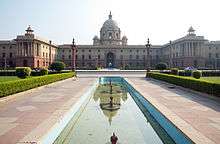
- Delhi’s history is etched over its landscape in stone. Magnificent forts, mosques and tombs of the Sultanate and Mughal periods evoke the aura of the medieval world while the stately layout and architecture of Lutyen’s Delhi bear the imposing imprint of British imperial rule.
- Upinder Singh, in Delhi: Ancient History, Berghahn Books, 1 August 2007, p. xi
- Delhi area has an incredibly long and eventful ancient past, beginning thousands of years ago in the stone age and merging at the other end into the medieval period when the Rajputs made-way for Delhi Sultans in the twelfth century.
- Upinder Singh, in Delhi: Ancient History, p.xi
- Delhi--created at the end of the 12th Century from the ruins of seven ancient cities--is a microcosm of all India. The city of 13 million people is the nation's capital and cultural heart. New Delhi is home to grand hotels, fashionable homes, spacious parks and broad promenades. Old Delhi is compact, crowded and chaotic.
- Harry Shattuck, in The old and the new of Delhi: Within city, it's a whole other world
- In its long history Delhi has been on several occasions the victim of military occupation accompanied by pillage and rapine, and these occasions have sometimes altered the course of the city’s fortunes, both materially and culturally. One such occasion was its capture by Qutubuddin Aibak on behalf of Sultan Muizud-Din Muhammad-ibn-Sam of Ghur in 1192 or 1193. Others, much later, were Nader Shah’s capture of the city in 1739, followed by its occupation by Ahamd Shah Durrani, the British in 1803, and the destruction which accompanied the uprising of 1857 and its suppression.
- Rakesh Kumar Bhatt, in History and Development of Libraries in India, Mittal Publications, 1 January 1995, P.172
- The period from 1724, to Nadir Shah’s invasion in 1739 was one of rapid internal decay of the empire, but one of outer brilliance for Delhi as far as its cultural life was concerned. The phase of 1740 to 1760 was period of growing anarchy.
- Rakesh Kumar Bhatt, in History and Development of Libraries in India, P.174
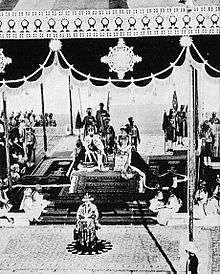
- Modern Delhi began with the slow revival of the city under British domination. During the ‘Delhi Renaissance’, approximately 1830 to the outbreak of uprising of 1857, Delhi exhibited the beginnings of a cultural ferment; Western technology and idea entered the city and supported each other.
- Rakesh Kumar Bhatt, in History and Development of Libraries in India, P.175
- Lord Lytton (1876-80) organised the Delhi Durbar in 1877 to entitle Queen Victoria Kaiser-i-Hind ...Delhi was made capital in place of Calcutta in 1912; Coronation Durbar of King George (V) and Queen Marry was held at Delhi in 1911.
- Muktikanta Mohanty, in Macmillan's General Knowledge Manual 2010, Macmillan, 1 February 2010, p. 17
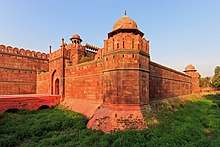
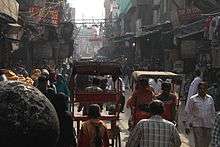
- Lal Qila, the massive 17th Century Red Fort, once was home to 5,000 residents. Built between 1639 and 1648 with red sandstone brought from Rajasthan by Mogul King Shah Jahan, the Red Fort is surrounded by a 1.5 mile wall. It initially served as the capital of Shah Jahan's empire. The same king commissioned construction of the Taj Mahal in Agra as a monument to his wife... A shopping bazaar is within.
- Harry Shattuck, in The old and the new of Delhi: Within city, it's a whole other world
- Old Delhi is bereft of splendor: Jama Masjid is the largest Muslim mosque in all of Asia. Dating to the 17th Century and commissioned by Shah Jahan, Asia's largest mosque was built of sandstone and black marble over six years by 5,000 laborers. Five gates remind Muslims that they are to pray five times daily, and up to 20,000 gather here--with women and men typically praying at different times. Climb the steps of a 130-foot-tall minaret for panoramic views of Old Delhi.
- Harry Shattuck, in The old and the new of Delhi: Within city, it's a whole other world
- Chandni Chowk is the street--an imperial avenue under Shah Jahan's reign--extends from the Red Fort. The name often is applied to connecting alleys and streets. It's jammed with makeshift shops, markets, rickshaws, carts drawn by horses and oxen, cows, goats and pedestrians.
- Harry Shattuck, in The old and the new of Delhi: Within city, it's a whole other world
- Partition was a total catastrophe for Delhi. Those who were left behind are in misery. Those who were uprooted are in misery. The Peace of Delhi is gone. Now it is all gone.
- Begum Hamida Sultan, in William Dalrymple City of Djinns: A Year in Delhi, Penguin, 25 March 2003 , p. 55
- Once through this ruined city did I pass
I espied a lonely bird on a bough and asked
What knowest thou of this wilderness?
It replied: 'I can sum it up in two words:
‘Alas, Alas!”- Khushwant Singh, in Delhi: A Novel, Penguin UK, 1 September 2010, p. 140
- Chief Minister Sheila Dikshit has betrayed the people of Delhi.
- It was a big challenge for me when I decided to start with the Sufi night. It took a while for the crowd to understand the music that was being played at the club since Delhi's crowd is more used to listening to hip-hop and Bollywood music, but the introduction of Sufi music definitely brought in a change.
- Akshay Anand, The Times of India (2012)
- The soil and climate in Delhi are also not favourable for anthrax.
- Delhi does not have legislations and policies which recognise the city’s values. The state government has not been able to identify the unique elements and outstanding universal values yet.
- Rohit Jigyasu, Deccan Herald (2012)
- As you go from New Delhi to Old Delhi suddenly, the streets are narrower. Suddenly, there are bicycle-rickshaws instead of cars. Suddenly, there are more people. Suddenly, everything is different.
- Raj Ahluwalia, in The old and the new of Delhi: Within city, it's a whole other world
- In Delhi one could manage a drink and dine off other people all 365 days...Delhi had over a hundred embassies, High Commissions and legations. Diplomats in Delhi did not have much work to do. Most of their energies were directed to wining and dining officials of the External Affairs and other ministries of the Government of India, cultivating non-official locals, and celebrating their independence days.
- Khushwant Singh, in The collected novels , Viking, 1996, p. 406
- That's Delhi. When life gets too much for you all you need to do is to spend an hour at Nigambodh Ghat, watch the dead being put to flames and hear their kin wail for them. Then come home and down a couple of pegs of whisky. In Delhi, death and drink make life worth living.
- Khushwant Singh, in Delhi: A Novel, p. 26
- They grouped into nativities - Bengalis, Biharis, Bandladeshis, South Indians, Northeasterners, Kashmiri Pandits and Punjabis - or sought refuge in professional identities. They were Delhiites because geography and the pursuit of common goals made them so and not because the city offered a unifying identity. Delhi now belonged to everyone who lived in it, but no one belonged to Delhi. The original Delhiites too were missing from public life - they preferred the city of memory.
- Anupreeta Das, in Seminar, Volumes 514-520, R. Thapar, 2002, p. 12
Quotes from pre-19th century sources
- See also History of Delhi
- After settling the affairs of Ajmir, the conqueror marched "towards Dehli (may God preserve its prosperity and perpetuate its splendour !) which is among the chief (mother) cities of Hind. When he arrived at Dehli, he saw " a fortress which in height and strength had not its equal nor second throughout the length and breadth of the seven climes." The army encamped around the fort. " A torrent of blood flowed on the field of battle, and it became evident to the chiefs that if they did not seek for safety from the sword of the king of the earth, and if they should deliver into the hands of Satan the time of option and the reins of good counsel, the condition of Dehli would be like that of Ajmir ; so from the dread of kingly punishment, the Rai and mukaddams of that country placed their heads upon the line of slavery, and their feet within the circle of obedience, and made firm the conditions of tribute [mdlguzdrt) and the usages of service.
- About the conquest of Delhi in the Ghurid era. Hasan Nizami. Elliot and Dowson, Vol. II : Elliot and Dowson, History of India as told by its own Historians, 8 Volumes, Allahabad Reprint, 1964. pp. 216. Also quoted in Jain, Meenakshi (2011). The India they saw: Foreign accounts.
- 'The conqueror entered the city of Delhi, which is the source of wealth and the foundation of blessedness. The city and its vicinity was freed from idols and idol-worship, and in the sanctuaries of the images of the Gods, mosques were raised by the worshippers of one Allah'...'Kutub-d-din built the Jami Masjid at Delhi, and 'adorned it with the stones and gold obtained from the temples which had been demolished by elephants,' and covered it with 'inscriptions in Toghra, containing the divine commands.
- About the conquest of Delhi in the Ghurid era. Hasan Nizami: Taju’l-Ma’sir, in Elliot and Dowson, Vol. II : Elliot and Dowson, History of India as told by its own Historians, 8 Volumes, Allahabad Reprint, 1964. pp. 219-23
- Many of them (Hindus) drew their swords and resisted… The flames of strife were thus lighted and spread through the whole city from Jahãnpanah and Siri to Old Delhi, burning up all it reached. The Hindus set fire to their houses with their own hands, burned their wives and children in them and rushed into the fight and were killed… On that day, Thursday, and all the night of Friday, nearly 15,000 Turks were engaged in slaying, plundering and destroying. When morning broke on Friday, all my army… went off to the city and thought of nothing but killing, plundering and making prisoners… The following day, Saturday the 17th, all passed in the same way, and the spoil was so great that each man secured from fifty to a hundred prisoners, men, women, and children. There was no man who took less than twenty. The other booty was immense in rubies, diamonds, garnets, pearls, and other gems and jewels; ashrafis, tankas of gold and silver of the celebrated Alãi coinage: vessels of gold and silver; and brocades and silks of great value. Gold and silver ornaments of Hindu women were obtained in such quantities as to exceed all account. Excepting the quarter of the Saiyids, the ulama and the other Musulmãns, the whole city was sacked.”
- Malfuzat-i Timuri (tr. Abū Ṭāleb Hosayni) by Timur. This book claims to be the autobiography of Timur, however the actual authorship of this work is disputed.
- On hearing of this, Nadir Shah came of the fort, sat in the golden masjid which was built by Rashanu-d daula, and gave orders for a general massacre. For nine hours an indiscriminate slaughter of all and of every degree was committed. It is said that the number of those who were slain amounted to one hundred thousand. The losses and calamities of the people of Delhi were exceedingly great…. After this violence and cruelty, Nadir Shah collected immense riches, which he began to send to his country laden on elephants and camels.
- About Nader Shah’s sack of Delhi, Tarikh-i Hindi by Rustam ‘Ali. In The History of India as Told by its own Historians. The Posthumous Papers of the Late Sir H. M. Elliot. John Dowson, ed. 1st ed. 1867. 2nd ed., Calcutta: Susil Gupta, 1956, vol. 22, pp. 37-67.
- On the morning of the 11th an order went forth from the Persian Emperor for the slaughter of the inhabitants. The result may be imagined; one moment seemed to have sufficed for universal destruction. The Chandni chauk, the fruit market, the Daribah bazaar, and the buildings around the Masjid-i Jama’ were set fire to and reduced to ashes. The inhabitants, one and all, were slaughtered. Here and there some opposition was offered, but in most places people were butchered unresistingly. The Persians laid violent hands on everything and everybody; cloth, jewels, dishes of gold and silver, were acceptable spoil.... But to return to the miserable inhabitants. The massacre lasted half the day, when the Persian Emperor ordered Haji Fulad Khan, the kotwal, to proceed through the streets accompanied by a body of Persian nasakchis, and proclaim an order for the soldiers to resist from carnage. By degrees the violence of the flames subsided, but the bloodshed, the devastation, and the ruin of families were irreparable. For a long time the streets remained strewn with corpses, as the walks of a garden with dead flowers and leaves. The town was reduced to ashes, and had the appearance of a plain consumed with fire.
- About Nader Shah’s sack of Delhi, Tazrikha by Anand Ram Mukhlis. A history of Nâdir Shah’s invasion of India. In The History of India as Told by its own Historians. The Posthumous Papers of the Late Sir H. M. Elliot. John Dowson, ed. 1st ed. 1867. 2nd ed., Calcutta: Susil Gupta, 1956, vol. 22, pp. 74-98.